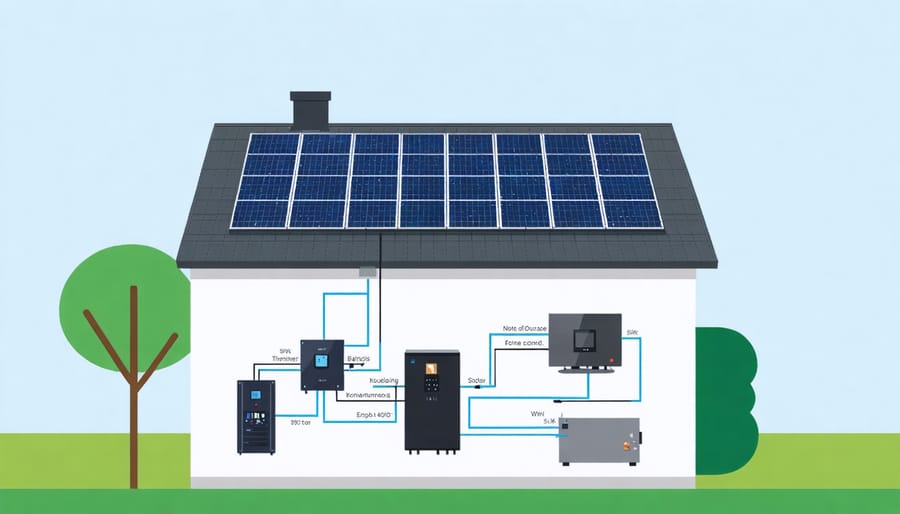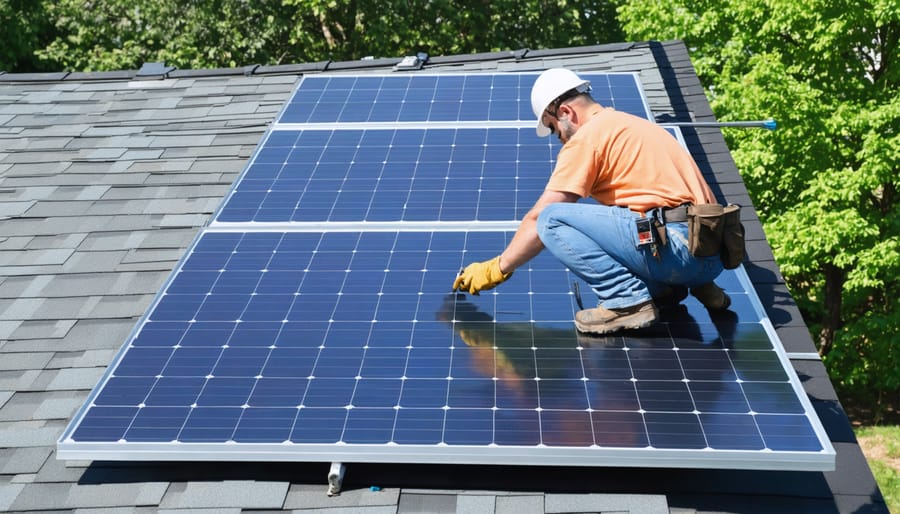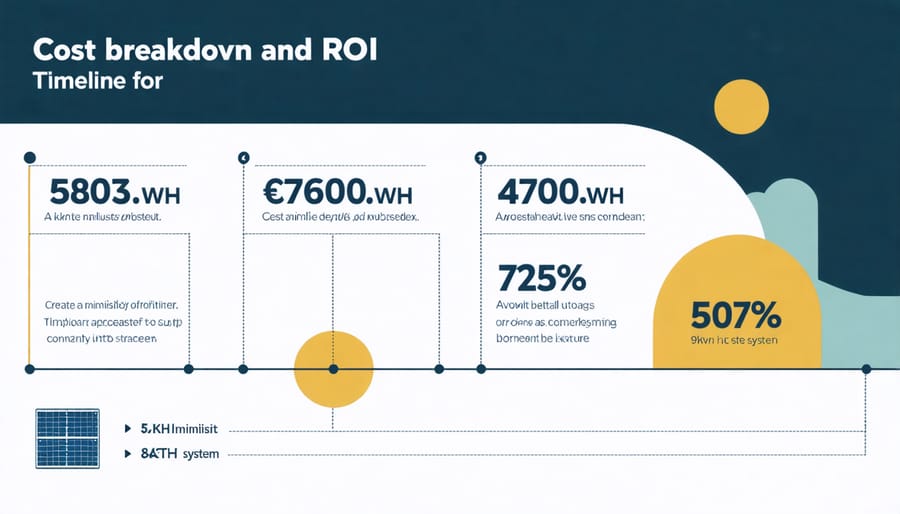Transform Your Home’s Energy with a 5kWh Solar System: The Perfect Balance of Power and Efficiency

Transform your home’s energy landscape with a 5kWh solar system – a powerful, mid-sized solar solution that perfectly balances efficiency and affordability for European households. This innovative system generates approximately 20-25 kWh of electricity daily, enough to power essential appliances and significantly reduce your carbon footprint while cutting energy costs by up to 70%.
As Europe accelerates its transition to renewable energy, 5kWh solar systems have emerged as the ideal choice for medium-sized homes, combining advanced photovoltaic technology with smart energy management capabilities. These systems typically consist of 15-20 high-efficiency solar panels, a robust inverter, and sophisticated monitoring equipment, offering a comprehensive solution for sustainable living.
Whether you’re looking to reduce your environmental impact, secure energy independence, or capitalize on generous European solar incentives, a 5kWh system delivers remarkable returns on investment. With an average payback period of 5-7 years and a lifespan exceeding two decades, this solar configuration represents a strategic investment in both environmental sustainability and long-term financial savings.
Understanding the 5kWh Solar System
Key Components and Configuration
A typical 5kWh solar installation requires carefully selected solar system components to ensure optimal performance. The foundation consists of 15-20 solar panels, typically monocrystalline or polycrystalline, collectively covering approximately 25-30 square metres of roof space. These panels are complemented by a grid-tied inverter rated at 5kW, which converts the DC power generated by the panels into usable AC electricity.
The system’s storage solution usually comprises a lithium-ion battery bank with 5kWh capacity, though some installations may opt for larger storage to maximize self-consumption. Essential mounting hardware includes sturdy aluminium rails, roof brackets, and cable management systems designed to withstand European weather conditions.
Additional components include DC isolators, AC circuit breakers, and smart monitoring systems that enable real-time performance tracking via smartphone applications. The configuration typically incorporates MC4 connectors, UV-resistant solar cables, and a proper earthing system to ensure safety and compliance with European regulations.

Ideal Applications and Home Compatibility
A 5kWh solar system is ideally suited for medium-sized European households with average daily electricity consumption between 16-20 kWh. These systems perform optimally on properties with unobstructed south-facing roof spaces of approximately 25-30 square metres, though east-west configurations can also yield efficient results with modern panel technologies.
This setup particularly benefits households with regular daytime energy usage patterns, such as families working from home or retirees. It’s especially effective for properties utilizing energy-efficient appliances and LED lighting, as these complement the system’s output capacity. The installation proves most valuable in regions receiving 2.5-4 hours of peak sunlight daily, typical across much of central and southern Europe.
For maximum compatibility, homes should feature modern electrical systems and adequate roof structural integrity. Properties with smart home integration capabilities can further optimize system performance through intelligent load management. While suitable for both urban and rural settings, the system delivers optimal results in areas without significant shade from neighbouring buildings or vegetation.
Heating and Cooling Capabilities
Solar-Powered Heating Solutions
A 5kWh solar system can effectively contribute to your home’s heating requirements through various innovative solutions. When integrated with a heat pump system, your solar installation can power efficient space heating and water heating applications, significantly reducing reliance on traditional energy sources.
The system works particularly well with modern electric underfloor heating systems, which operate at lower temperatures and maintain consistent warmth throughout your living spaces. During peak sunlight hours, your 5kWh system can directly power these heating elements, while excess energy can be stored in batteries for evening use.
For optimal heating efficiency, combining your solar system with a water tank thermal storage solution allows you to capture and retain solar-generated heat energy. This stored thermal energy can then be utilized during non-sunny periods or at night, ensuring a steady supply of hot water and maintaining comfortable indoor temperatures.
In European climates, where heating demands vary seasonally, smart controllers can help maximize the system’s heating potential. These devices prioritize heating during peak solar production hours and automatically switch to grid power when necessary, optimizing both comfort and energy efficiency.
While a 5kWh system may not cover all heating needs during winter months, it can substantially reduce heating costs throughout the year, with particularly strong performance during spring and autumn when heating requirements are moderate and solar availability is good.
Cooling System Integration
Modern solar-powered cooling systems integrated with 5kWh solar installations offer year-round climate control solutions for European homes and businesses. The system’s cooling capabilities are particularly effective during peak summer months when solar energy generation is at its highest, creating a natural synergy between energy production and cooling demands.
During summer operation, the system can maintain comfortable indoor temperatures between 20-24°C while consuming minimal grid electricity. The cooling capacity typically ranges from 3.5 to 4.2 kW, sufficient for cooling approximately 80-100 square meters of living space, depending on building insulation and local climate conditions.
In shoulder seasons (spring and autumn), the system demonstrates remarkable efficiency by adapting to varying temperature requirements. The intelligent control system optimizes energy distribution between cooling needs and other household applications, ensuring maximum utilization of generated solar power.
Performance metrics show that integration with thermal storage solutions can extend cooling capabilities into evening hours, addressing one of the traditional limitations of solar-powered systems. The seasonal coefficient of performance (SCOP) typically ranges between 3.5 and 4.2, indicating excellent energy efficiency across different weather conditions.
For optimal performance, the system includes advanced monitoring capabilities that adjust cooling output based on real-time solar generation, ambient temperature, and user preferences, maximizing both comfort and energy efficiency.
Installation and Integration

Professional Installation Requirements
A 5kWh solar system installation requires careful planning and professional expertise to ensure optimal performance and compliance with European regulations. The process typically begins with a thorough site assessment, evaluating factors such as roof orientation, structural integrity, and shading patterns. Professional installers will conduct detailed measurements and create a customised installation plan.
The installation team must include certified electricians who understand both AC and DC electrical systems, as well as specialists familiar with current European solar energy standards. Key requirements include proper mounting hardware, compatible inverters, and safety equipment that meets EU specifications.
The installation process usually takes 2-3 days and involves several crucial steps: mounting the support structure, installing solar panels, connecting the inverter system, implementing safety mechanisms, and establishing monitoring capabilities. Weather-tight roof penetrations and proper cable management are essential for long-term system reliability.
Local building permits and grid connection agreements must be secured before installation begins. Additionally, installers need to coordinate with local utilities for meter installation and ensure compliance with specific regional requirements. Post-installation, professional testing and commissioning are necessary to verify system functionality and safety standards.
Integration with Existing Systems
Integrating a 5kWh solar system with your existing home infrastructure requires careful planning and consideration of several key factors. First, assess your current electrical setup, including the main distribution board and wiring capacity. Most modern European homes can accommodate solar integration without major modifications, but older properties may need electrical system upgrades to ensure safe operation.
The inverter placement is crucial for optimal system performance. Install it in a cool, dry location, preferably close to your main electrical panel to minimize power losses. For homes with smart energy management systems, ensure your chosen inverter is compatible with common protocols used in European smart home setups.
Battery storage integration should be considered during the planning phase. While not mandatory, storage systems enhance self-consumption rates and provide backup power during grid outages. Modern hybrid inverters make this integration seamless, allowing for future expansion of storage capacity.
If you have existing heating or hot water systems, consider connecting your solar setup to these through an intelligent control system. This maximizes energy efficiency by directing excess solar power to heat water or support home heating when available. Many European installers now offer comprehensive integration services, ensuring all components work together harmoniously while complying with local grid regulations and building codes.
Cost and Energy Savings Analysis
Initial Investment and Incentives
The initial investment for a 5kWh solar system in Europe typically ranges from €4,500 to €7,000, depending on equipment quality, installation requirements, and regional variations. This cost includes solar panels, inverters, mounting hardware, and professional installation. When considering the complete system with solar battery costs, the investment may increase by €3,000 to €5,000.
Fortunately, European homeowners can access various incentives to offset these costs. The EU Solar Energy Strategy provides substantial support through national programs, with many countries offering direct subsidies covering 20-30% of the installation costs. Tax benefits are also available, including reduced VAT rates and income tax deductions in several member states.
Key national incentives include Germany’s KfW program, offering low-interest loans and grants, France’s MaPrimeRénov scheme providing direct subsidies, and Italy’s Superbonus initiative supporting comprehensive energy renovations. Local municipalities often supplement these with additional incentives, such as simplified permit processes and regional grants.
Most European installers now offer flexible financing options, including solar loans and lease arrangements, making the initial investment more manageable. When combined with available incentives, many homeowners can expect a return on investment within 5-7 years, considering current energy prices and consumption patterns.
Long-term Savings and ROI
A 5kWh solar system represents a significant long-term investment that typically delivers substantial financial returns through reduced energy bills and various incentive schemes. In most European regions, homeowners can expect to see their electricity bills decrease by 50-70% after installation, depending on local solar conditions and energy consumption patterns.
The initial investment for a 5kWh system, including installation, generally ranges from €5,000 to €7,500 in most European markets. However, with current electricity prices and available government incentives, the system usually pays for itself within 5-7 years. This calculation factors in annual energy savings of approximately €800-1,200, depending on local electricity rates and consumption patterns.
The long-term financial benefits extend well beyond the initial payback period. With a typical system lifespan of 25-30 years, homeowners can expect to generate significant savings over time. Modern solar panels maintain about 85% of their efficiency even after 25 years, ensuring consistent returns throughout their lifetime.
Additionally, many European countries offer feed-in tariffs or net metering programs, allowing homeowners to sell excess energy back to the grid. Combined with increasing electricity prices, which have historically risen by 3-4% annually, the real return on investment often exceeds initial projections. When factoring in property value increase, which typically rises by 3-4% with solar installation, the financial benefits become even more compelling.

Maintenance and Optimization
Regular maintenance is crucial to ensure your 5kWh solar system operates at peak efficiency throughout its lifespan. Start with monthly visual inspections of your solar panels to check for dust, debris, or potential damage. In European climates, seasonal cleaning is typically sufficient, though areas with higher pollution or dust levels may require more frequent attention.
To optimize your solar system, monitor your energy production through your inverter’s monitoring system. Unexpected drops in generation could indicate issues requiring professional attention. Keep vegetation trimmed to prevent shading, and ensure panels maintain their optimal tilt angle, especially if you have adjustable mounting systems.
Annual professional inspections are recommended to check electrical connections, inverter performance, and mounting structure integrity. These inspections should include thorough testing of safety systems and verification of proper grounding. During winter months in northern Europe, clear snow accumulation promptly to maintain generation capacity.
Consider upgrading your monitoring software to take advantage of smart features that can alert you to performance issues. Keep detailed records of maintenance activities and energy production patterns to identify potential problems early. This proactive approach to system care will help maximize your investment’s return and ensure consistent renewable energy production for years to come.
A 5kWh solar system represents a significant step towards energy independence and environmental responsibility. By generating clean, renewable energy, these systems not only reduce electricity bills but also contribute to Europe’s broader sustainability goals. The combination of advanced technology, decreasing installation costs, and improved efficiency makes this solution increasingly attractive for both homeowners and businesses.
The benefits extend beyond immediate cost savings. With proper maintenance, these systems can provide reliable power for 25+ years while increasing property value and reducing carbon footprint. European incentives and support schemes further enhance the financial appeal, making the transition to solar energy more accessible than ever.
As we face growing environmental challenges and energy security concerns, investing in a 5kWh solar system demonstrates leadership in sustainable practices. Whether powering a family home or supporting business operations, these systems represent a practical, future-proof solution for energy needs. By embracing solar technology today, we contribute to a cleaner, more sustainable tomorrow while enjoying the immediate advantages of renewable energy independence.
Consider taking the first step towards solar adoption – the environmental and economic benefits make it a decision you won’t regret.
Leave a Reply